| News Archive |

|
2008: Jan Feb Mar Apr May Jun Jul Aug Sep Oct Nov Dec
2007: Jan Feb Mar Apr May Jun Jul Aug Sep Oct Nov Dec
2006: Jan Feb Mar Apr May Jun Jul Aug Sep Oct Nov Dec
2005: Jan Feb Mar Apr May Jun Jul Aug Sep Oct Nov Dec
2004: Jan Feb Mar Apr May Jun Jul Aug Sep Oct Nov Dec

News: July 2008
Back to latest news

|
 |
Watch the eclipse with experts in London tomorrow
The Society for Popular Astronomy (SPA) will be gathering with telescopes in London’s Hyde Park tomorrow (Friday 1 August) to allow the public and press to safely view and enjoy the partial eclipse of the Sun.
 FULL STORY FULL STORY
 |
 |
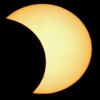 |
 |
Titan’s liquid lakes
Cassini scientists have presented unrivalled evidence for the presence of ethane lakes on Saturn’s moon Titan, the first definitive example of liquid surface reservoirs on a planetary body other than the Earth.
 FULL STORY FULL STORY
 |
 |
 |
 |
Supervoids and superclusters point to
dark energy
By studying regions of space with an above and below average concentration of galaxies – superclusters and supervoids, respectively – a team of astronomers have found direct evidence for the existence of dark energy.
 FULL STORY FULL STORY
 |
 |
 |
 |
Barred spiral galaxies arrive late in the Universe
In a landmark study of more than 2,000 spiral galaxies, Hubble astronomers have found that barred spiral galaxies were far less abundant 7 billion years ago than they are today in the local Universe, an important ramification for galaxy evolution.
 FULL STORY FULL STORY
 |
 |
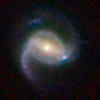 |
 |
Sticky situation for Phoenix
After two failed attempts to deliver a sample of icy soil to Phoenix’s TEGA oven over the weekend, it’s back to the drawing board to figure out a way to get this surprisingly sticky soil out of the robotic scoop.
 FULL STORY FULL STORY
 |
 |
 |
 |
Partial solar eclipse visible from UK this Friday
On 1 August there will be a total eclipse of the Sun visible from Canada, northern Greenland, Svalbard, the Barents Sea, Russia, Mongolia and China, but you don’t need to travel miles to see a partial eclipse because one-third to one-tenth of the Sun will be obscured from view right across
Great Britain.
 FULL STORY FULL STORY
 |
 |
 |
 |
Supernova explodes in controversy
The interpretation of supernova explosion
SN 2008D, which was captured by a serendipitous Swift telescope observation earlier this year, is causing controversy among different research groups who argue its origin and evolution as either a ‘normal’ supernova, or something more reminiscent of a gamma-ray burst.
 FULL STORY FULL STORY
 |
 |
 |
 |
It IS rocket science!
If you’re planning on visiting the Edinburgh Fringe Festival this summer and fancy some light-hearted ‘space-based silliness’, then make sure Helen Keen’s show – It Is Rocket Science – is on your itinerary.
 FULL STORY FULL STORY
 |
 |
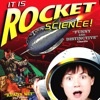 |
 |
Stellar vampires make the Universe dusty
For the first time, astronomers have witnessed the expulsion of a shell of dusty gas around a freshly erupted nova and tracked its evolution for over 200 days, providing a new and invaluable way of estimating the distances to nearby novae.
 FULL STORY FULL STORY
 |
 |
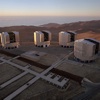 |
 |
New planet announced today at Scottish
astronomy conference
The discovery of a Jupiter-sized planet was announced earlier today at the international ‘Cool Stars, Stellar Systems and the Sun’ conference hosted by the University of St Andrews in Scotland.
 FULL STORY FULL STORY
 |
 |
 |
 |
Infrared sunglasses see black hole discs
For the first time astronomers have found a way to obtain a clean view of the discs that theorists say should surround black holes, by using a polarising filter that only shows up the discs’ infrared properties.
 FULL STORY FULL STORY
 |
 |
 |
 |
The SUPA search for extraterrestrial worlds
Combining efforts and resources, researchers in the Scottish Universities Physics Alliance (SUPA) have emerged near the top of the international league when it comes to studying the possibility of life elsewhere in the Universe.
 FULL STORY FULL STORY
 |
 |
 |
 |
Gravitational lensing weighs 70 galaxies and infers
dark matter
In the largest ever single collection of gravitational lens galaxies, an international team of astronomers have helped settle a long-standing debate over the relationship between mass and luminosity in galaxies,
and used the results to infer the presence of dark matter.
 FULL STORY FULL STORY
 |
 |
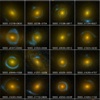 |
| |
Phoenix in 24-hour monitoring assignment
To coordinate with observations made by the Mars Reconnaissance Orbiter flying repeatedly overhead, NASA's Phoenix Mars Lander stayed up all night for the first time on Monday to make simultaneous measurements of the atmosphere and ground.
 FULL STORY FULL STORY
 |
 |
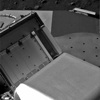 |
 |
Fourth dwarf planet named as 'Makemake'
The International Astronomical Union (IAU) has named the object formerly known as 2005 FY9 as ‘Makemake’, after the Polynesian creator of humanity and the god of fertility.
 FULL STORY FULL STORY
 |
 |
 |
 |
Organic cemeteries could dominate ancient Mars
Two complementary studies based on data from NASA's Mars Reconnaissance Orbiter support the popular theory that the Red Planet once hosted vast lakes, flowing rivers and a variety of other wet environments that had the potential to support life.
 FULL STORY FULL STORY
 |
 |
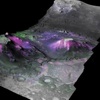 |
 |
'No organics' zone circles Pinwheel galaxy
The Pinwheel galaxy, which is dominated by tangled spiral arms, has been observed through Spitzer’s infrared eyes, revealing a zone in which organic molecules suddenly disappear.
 FULL STORY FULL STORY
 |
 |
 |
 |
XMM detects nova everyone else missed
It was one of the brightest nova events of the decade and clearly visible to the naked eye, yet no one but the XMM-Newton space telescope was there for the party.
 FULL STORY FULL STORY
 |
 |
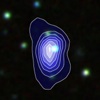 |
 |
The Pole Star reborn
The Northern Star, whose vibrations were thought to be dying away, appears to have come to life again, and the vibrations are on the rise, say astronomers presenting their research at the ‘Cool Stars 15’ conference at the University of St Andrews today.
 FULL STORY FULL STORY
 |
 |
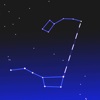 |
 |
Closing in on Venus
Unexplored regions of Venus will soon be within the reach of Venus Express, which is executing a series of manoeuvres to gradually bring it closer to its host planet.
 FULL STORY FULL STORY
 |
 |
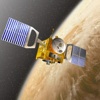 |
 |
Mars Express has Phobos
in sight
Scientists and engineers are preparing ESA's Mars Express for several close fly-bys of the Martian moon Phobos, in the quest to settle debate on the origin of the red planet's two rocky satellites.
 FULL STORY FULL STORY
 |
 |
 |
 |
Earth filmed as alien world
From a distance of 31 million miles, NASA's Deep Impact spacecraft, now operating under the name of EPOXI, has captured the transit of the Moon as it passes in front of the Earth, an observation that will help scientists develop techniques to study alien worlds.
 FULL STORY (includes video) FULL STORY (includes video)
 |
 |
 |
 |
All change for Jupiter’s
red spots
The Hubble Space Telescope has captured a serious shake up in Jupiter’s turbulent atmosphere as the planet’s two smaller red spots play cat and mouse with their big brother, the well-established Great Red Spot.
 FULL STORY FULL STORY
 |
 |
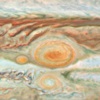 |
 |
Phoenix rasps frozen layer and scoops sample
Using the robotic arm’s powered rasp, Phoenix has successfully drilled into the cement-hard frozen soil at its landing site, loosening material that was later collected by the lander's scoop.
 FULL STORY FULL STORY
 |
 |
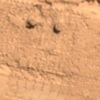 |
 |
Chandra weighs up supermassive black hole
Until now, the mass of a black hole has been assessed by studying the motions of proximal stars and gas, but thanks to an innovative new technique, these measurements can now also be derived from the temperatures of hot gasses compressed in the jaws of these celestial cannibals.
 FULL STORY FULL STORY
 |
 |
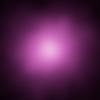 |
 |
Brightest star in the Galaxy has new competition
Eta Carinae has a new rival for its long-held title of brightest star in the Milky Way, in the shape of the Peony nebula star that resides in the dusty metropolis of the Galaxy’s centre and blazes with the light of 3.2 million Suns.
 FULL STORY FULL STORY
 |
 |
 |
 |
Water dampens Moon formation theory
An important conclusion of the Apollo and Luna programmes was that the Moon is deficient in highly volatile elements – including water – compared to the Earth, but in a new analysis of lunar rocks, scientists have detected enough water to require the classical models of lunar formation and evolution to be reconsidered.
 FULL STORY FULL STORY
 |
 |
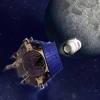 |
 |
Mystery star cluster with three birthdays
Astronomers have found three groups of stars in the same open star cluster that seem to have different ages, challenging some of the fundamental principles used to estimate cluster ages.
 FULL STORY FULL STORY
 |
 |
 |
 |
First success with Phoenix soil probe and atomic force microscope
NASA's Phoenix Mars Lander has prodded Martian soil with its Thermal and Electrical Conductivity Probe (TECP) for the first time, and has begun using a microscope that examines the shapes of tiny soil particles by touching them.
 FULL STORY FULL STORY
 |
 |
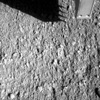 |
 |
Galactic baby boom in distant Universe
Astronomers have found a rare galaxy located in the remote Universe that is pumping out stars at a rate of up to 4,000 per year, defying the most common theory of galaxy formation.
 FULL STORY FULL STORY
 |
 |
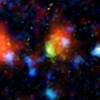 |
 |
Phoenix struggling with
icy payload
NASA's Phoenix Mars Lander's science and engineering teams are still testing methods to get an icy sample into the Robotic Arm scoop for delivery to the Thermal and Evolved Gas Analyser (TEGA).
 FULL STORY FULL STORY
 |
 |
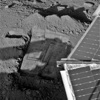 |
 |
Small fraction of Sun-like stars produce planets
Fewer than 10 percent of stars in the Orion Nebula have enough dust to make Jupiter-sized planets or larger, say astronomers from the University of California, Berkeley, the California Institute of Technology and the Harvard-Smithsonian Centre for Astrophysics, suggesting that Sun-like stars have a low probability of forming planets.
 FULL STORY FULL STORY
 |
 |
 |
 |
New research puts asteroids in a spin
Binary asteroids – asteroids with moons – are common throughout the Solar System, but questions surrounding their formation have long been speculated. According to new research conducted by scientists from the University of Maryland and the Cote d’Azur Observatory, the answer lies in the Sun.
 FULL STORY FULL STORY
 |
 |
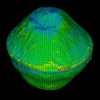 |
 |
STFC announces bitter-sweet £2 billion funding programme
The Science and Technology Facilities Council (STFC) have announced a three year £1.906 billion funding programme for UK physics and astronomy, but at the cost of several major projects in an attempt to recoup some of its £80 million shortfall.
 FULL STORY FULL STORY
 |
 |
 |
 |
Rosetta wakes from hibernation for asteroid flyby
ESA’s comet-chasing Rosetta spacecraft has awoken from hibernation to prepare for its encounter with rare asteroid (2867) Steins on 5 September as it speeds through the Solar System en route to comet 67/P Churyumov-Gerasimenko, where it will make the first ever landing attempt on a comet.
 FULL STORY FULL STORY
 |
 |
 |
 |
Anaemic Mercury dominated by volcanism
In January 2008, MESSENGER became the first probe to fly past the planet Mercury in 33 years. In a special edition of Science released today, 11 papers describe the findings of that flyby, revealing the innermost planet of our Solar System as surprisingly deficient in iron, and having suffered a decidedly volcanic past.
 FULL STORY FULL STORY
 |
 |
 |
 |
New Horizons team celebrates 30th anniversary of Charon’s discovery
On July 7 1978, Pluto was officially given its first moon, Charon, and just three years ago astronomers found two more. In seven years time Pluto will welcome its first artificial satellite – New Horizons – that will turn these distant bodies from points of light into well-mapped worlds.
 FULL STORY FULL STORY
 |
 |
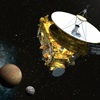 |
 |
Next Phoenix bake could be last
After a busy weekend of scraping up piles of icy soil, Phoenix is preparing its ovens to sniff out the ingredients of this precious material, but a short circuit problem could make this the last trip to the Phoenix bakery.
 FULL STORY FULL STORY
 |
 |
 |
 |
First measurements of the termination shock
Voyager 2 crossed the solar wind termination shock last year, making the first direct measurements of the region where the hot solar wind slams into the cold interstellar medium, while the twin solar STEREO spacecraft unexpectedly detected particles emanating from the same locality, from their viewpoint in Earth orbit around the Sun.
 FULL STORY FULL STORY
 |
 |
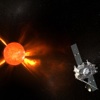 |
 |
The stars and stripes of the Universe
The Hubble Space Telescope has captured a delicate ribbon of gas floating eerily in our Galaxy, a ghostly reminder of a supernova explosion that occurred over 1,000 years ago, and which is still expanding at almost 10 million kilometres per hour today.
 FULL STORY FULL STORY
 |
 |
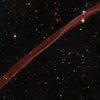 |
 |
Cluster listens to the sounds of the Earth
ESA’s Cluster mission has been tuning in to the Earth’s aurora, listening out for an emission that may help the search for alien worlds in the future.
 FULL STORY FULL STORY
 |
 |
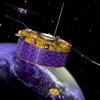 |
 |
 |

Back to latest news |
 |

